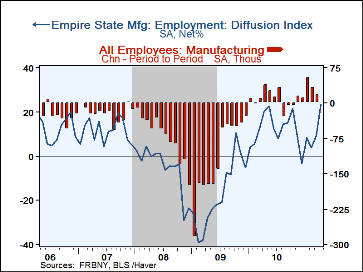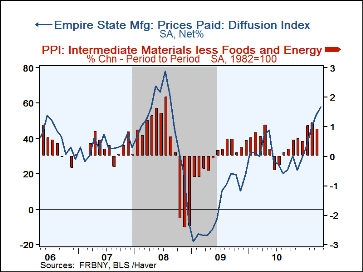 Global| Apr 15 2011
Global| Apr 15 2011Empire State Factory Index Reaches Twelve-Month High
by:Tom Moeller
|in:Economy in Brief
Summary
The Federal Reserve Bank of New York reported that its Empire State Factory Index of General Business Conditions rose to 21.70, its highest level since April of last year. The figure beat Consensus expectations for a stable reading of [...]
 The Federal Reserve Bank of New York reported that its Empire State
Factory Index of General Business Conditions rose to 21.70, its
highest level since April of last year. The figure beat
Consensus expectations for a stable reading of 17.3. Nevertheless, the index remained below
last year's high of 29.71. These figures are diffusion indexes which are
calculated by subtracting the percent of respondents reporting the
indicator lower from those reporting the indicator higher. Thus, they have
a good correlation with growth in the series covered. Since inception in
2001, the business conditions index has a 78% correlation with the
quarterly change in real GDP.
The Federal Reserve Bank of New York reported that its Empire State
Factory Index of General Business Conditions rose to 21.70, its
highest level since April of last year. The figure beat
Consensus expectations for a stable reading of 17.3. Nevertheless, the index remained below
last year's high of 29.71. These figures are diffusion indexes which are
calculated by subtracting the percent of respondents reporting the
indicator lower from those reporting the indicator higher. Thus, they have
a good correlation with growth in the series covered. Since inception in
2001, the business conditions index has a 78% correlation with the
quarterly change in real GDP.
Improvement was greatest in the shipments, new orders, pricing and employment subseries. During the last ten years there has been an 82% correlation between the jobs index and the m/m change in factory sector payrolls. Also, since inception, there has been a 68% correlation between the index of prices paid and the monthly change in the core intermediate materials PPI.
The Empire State index of expected business conditions in six months slipped m/m to 47.44 and was down from the January high of 58.95. A separate series for capital spending improved m/m while the technology index also rose.
The Empire State data is available in Haver's SURVEYS database. The figures are diffusion indexes. Like the Philadelphia Fed Index of General Business Conditions, the Empire State Business Conditions Index reflects answers to independent survey questions; it is not a weighted combination of the components. The series dates back only to 2001.
| Empire State Manufacturing Survey | Apr | Mar | Feb | Mar'10 | 2010 | 2009 | 2008 |
|---|---|---|---|---|---|---|---|
| General Business Conditions (diffusion index, %) | 21.70 | 17.50 | 15.43 | 29.71 | 13.80 | -2.81 | -9.96 |
| New Orders | 22.34 | 5.81 | 11.80 | 28.10 | 9.93 | -2.51 | -6.23 |
| Inventories | -1.28 | 3.90 | 9.64 | 11.39 | 0.00 | -22.89 | -7.87 |
| Employment | 23.08 | 9.09 | 3.61 | 20.25 | 11.78 | -17.28 | -5.36 |
| Prices Paid | 57.69 | 53.25 | 45.78 | 41.77 | 29.63 | 1.33 | 46.99 |
Tom Moeller
AuthorMore in Author Profile »Prior to joining Haver Analytics in 2000, Mr. Moeller worked as the Economist at Chancellor Capital Management from 1985 to 1999. There, he developed comprehensive economic forecasts and interpreted economic data for equity and fixed income portfolio managers. Also at Chancellor, Mr. Moeller worked as an equity analyst and was responsible for researching and rating companies in the economically sensitive automobile and housing industries for investment in Chancellor’s equity portfolio. Prior to joining Chancellor, Mr. Moeller was an Economist at Citibank from 1979 to 1984. He also analyzed pricing behavior in the metals industry for the Council on Wage and Price Stability in Washington, D.C. In 1999, Mr. Moeller received the award for most accurate forecast from the Forecasters' Club of New York. From 1990 to 1992 he was President of the New York Association for Business Economists. Mr. Moeller earned an M.B.A. in Finance from Fordham University, where he graduated in 1987. He holds a Bachelor of Arts in Economics from George Washington University.








